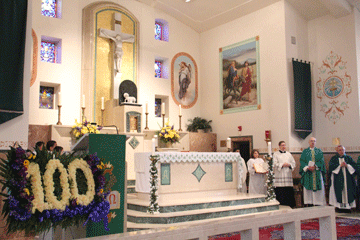First it was St. Peter, then St. Rocco and finally Mater Dolorosa, all within three years.
Mater Dolorosa, in the Frankford section of Philadelphia, observed its centennial Sept. 18 with a Mass celebrated by Philadelphia’s new Archbishop, Charles Chaput. It was officially founded as an Italian personal parish in 1911, but its history as a worshipping community traces back to 1908.
That’s the year Father Ernesto Santoro opened a little chapel in a storefront on Unity Street under the patronage of St. Peter to serve the growing immigrant population of the neighborhood. Shortly, after this it was changed St. Rocco, and the final name, Mater Dolorosa (Sorrowful Mother) was not chosen until 1911, the year the parish was formally erected.
The property at Paul and Ruan Streets was purchased in 1913 by Mater Dolorosa’s second pastor Father Cosmos Bruni, and the permanent church was dedicated in 1914.
A parish school opened in 1926 under the direction of Franciscan Missionaries of the Sacred Heart, and they were succeeded by the Sisters, Servants of the Immaculate Heart of Mary in the 1970s. At this time the children attend Holy Innocents Area Catholic School.
“My bloodlines flow through the sanctuary at Mater Dolorosa; I was an altar boy there. My grandparents on both sides were early parishioners. The church was not just a spiritual center. It was a community center, and it was the rock of the community.” — Lou Altomare
Most of the parish history was under two great pastors, notes Father John Large, Mater Dolorosa’s pastor. The first was Father Bruni who served from 1911 to 1945, a man of outstanding charity.
“I have a parishioner who told me during the Depression when she was a little girl, her mother sent her with her wagon to Father Bruni to tell him her family didn’t have coal,” Father Large said. “He told her to go down to the rectory basement and take what she needed. She remembers at the same time he was working in his office wearing his overcoat and gloves with the fingers cut out so he could write. He would not use the coal his people needed.”
Father Bruni was succeeded by Father Albert Palombo, who served 37 years and was especially effective in getting new immigrants settled with housing furnishing and employment, but he remained very much a man of the people.
Today, the parish is in effect twinned with nearby St. Joan of Arc, where Father Large also celebrates Mass. It is an area where many people don’t register with the parish, but they are there anyway.
Thanks to the work of St. Joseph Sisters Linda Lukieski and Eileen Crooke, mostly through door-to-door ministry, evangelization is being accomplished.
“We have 14 people in RCIA and about 30 kids in PREP,” Father Large said.
Lou Altomare, who is chair of the centennial committee but no longer lives in Frankford, continues to support Mater Dolorosa as well as his Bucks County parish.
“My bloodlines flow through the sanctuary at Mater Dolorosa; I was an altar boy there,” he said. “My grandparents on both sides were early parishioners. The church was not just a spiritual center. It was a community center, and it was the rock of the community.”
Like Altomare, many of the old Italian families have prospered and moved away. “I’m living my grandfathers’ dream,” he said, adding their place has been taken by Hispanics, for whom the parish now offers Spanish language Masses, celebrated by Vincentian Father Joseph Cummins, and that is fine with him.
“History is repeating itself,” he said. “We are fortunate to have the Hispanic community.”
Nellie Dicupe, who is a cantor at the parish’s English Masses, is first-generation American of Puerto Rican ancestry, and her family moved into the parish about 23 years ago when there were very few Hispanics, but she can honestly say she has never felt unaccepted. “It’s a very vibrant parish,” she said. She recalls her father, who was active with Spanish-language Charismatics, tried to get a group started in the parish, but couldn’t at the time, but now there is one.
Rose (Juliani) Flemming also has deep roots in the parish. “My mom and dad were both born in Italy, but our whole family went to Mater Dolorosa,” she said. “It’s a terrific parish. I love it.”
She is not at all surprised that Dicupe and other Hispanics have always felt at ease in the parish.
“Why not accept them? They are part of the parish,” Flemming said. “We all stick together, and whatever we do is as one. We all chip in and help each other and everything flows.”
Over the years she lived for a time in other parishes, but for her, there is nothing like Mater Dolorosa. “We’ve had good priests, and it’s a great little parish,” she said.
PREVIOUS: Archdiocesan social services programs singled out for national award
NEXT: Teachers ratify new contract




I was an alter boy there& grad of nech 1968